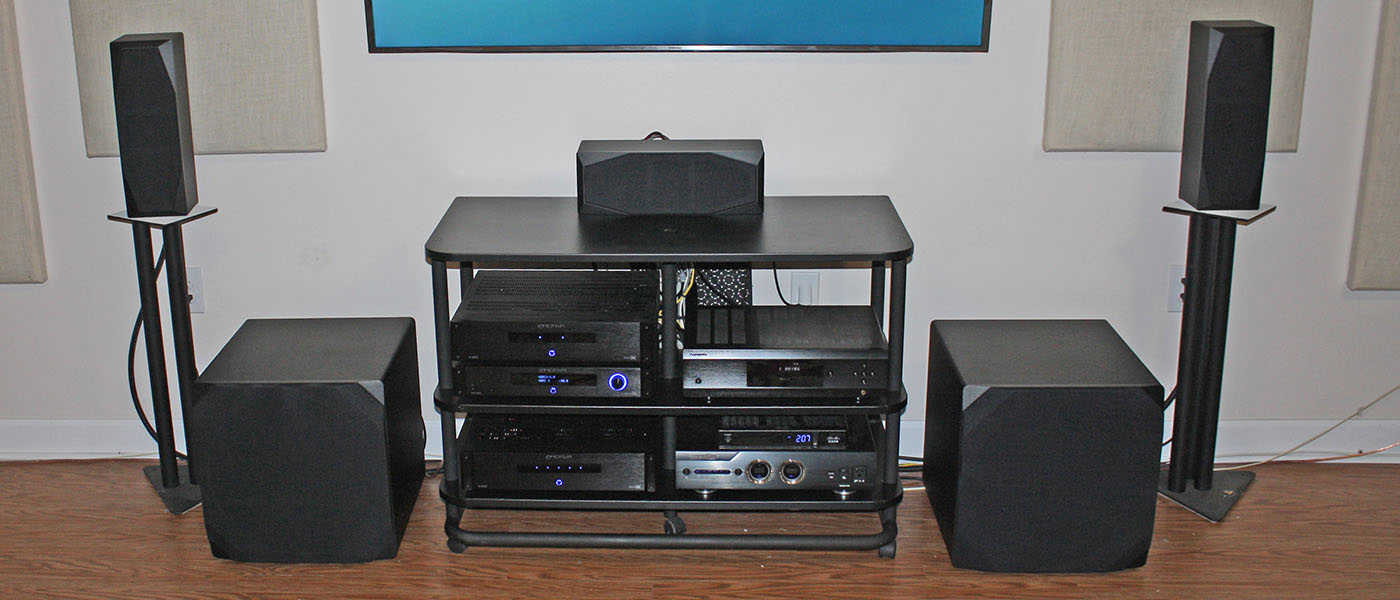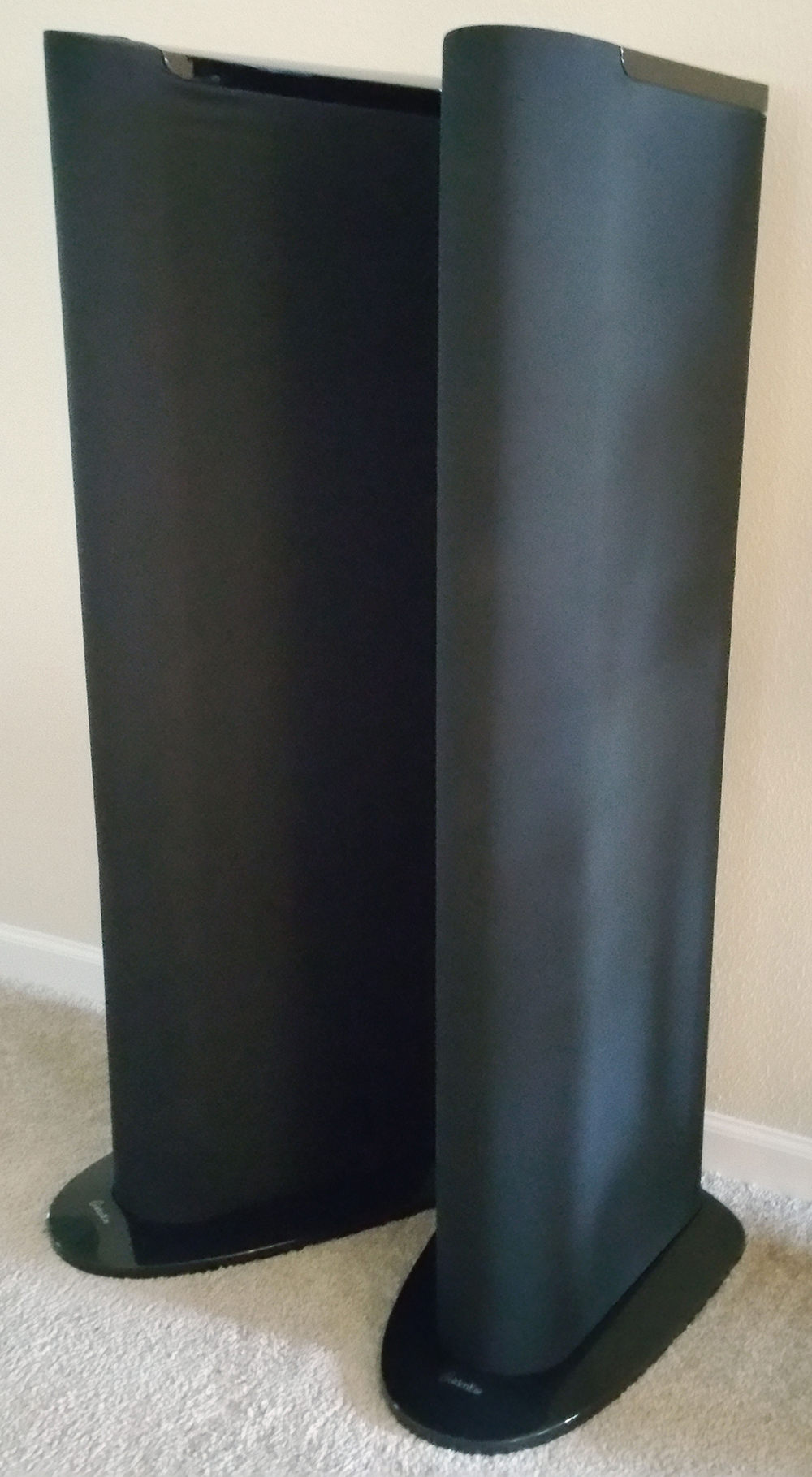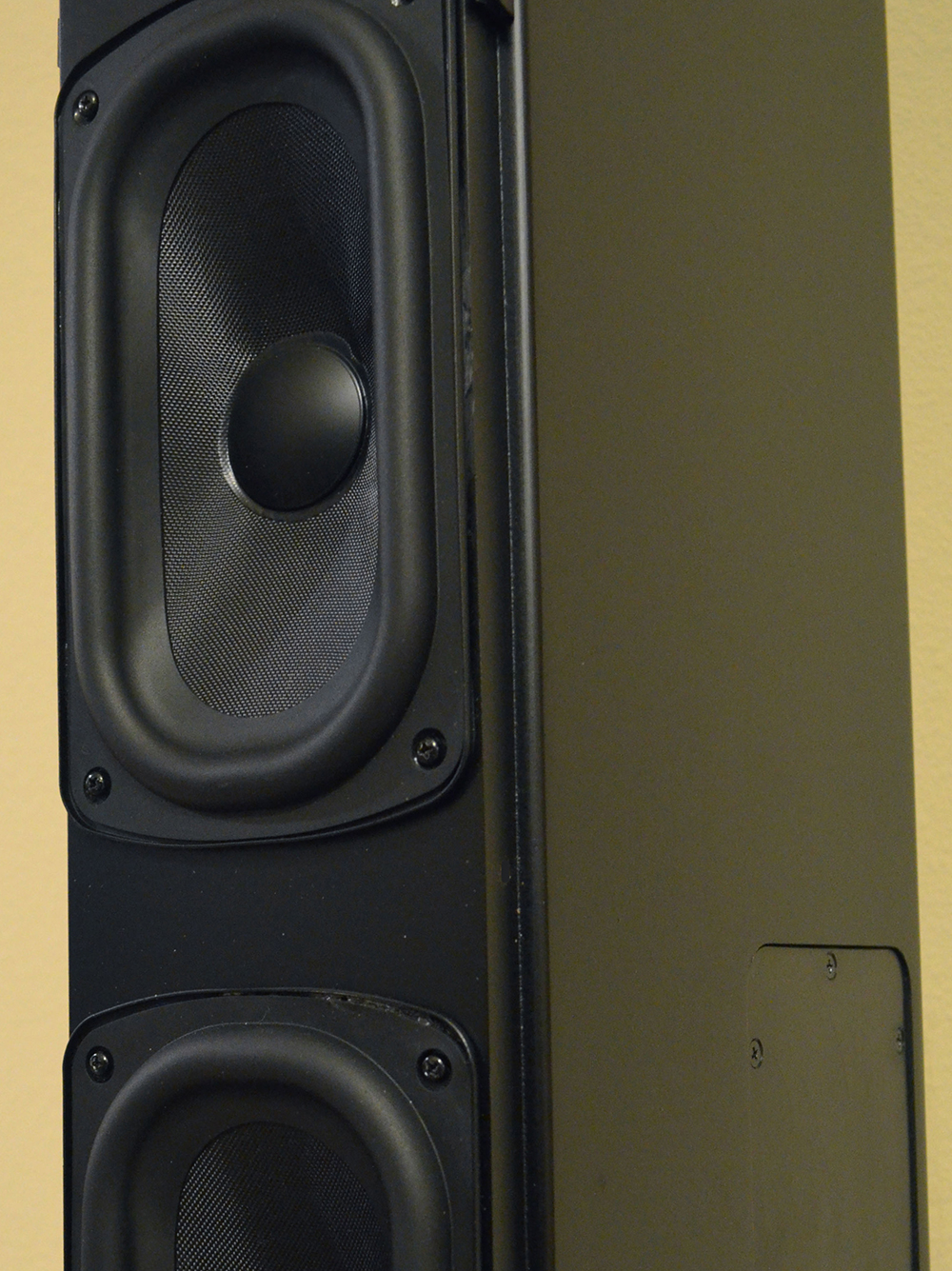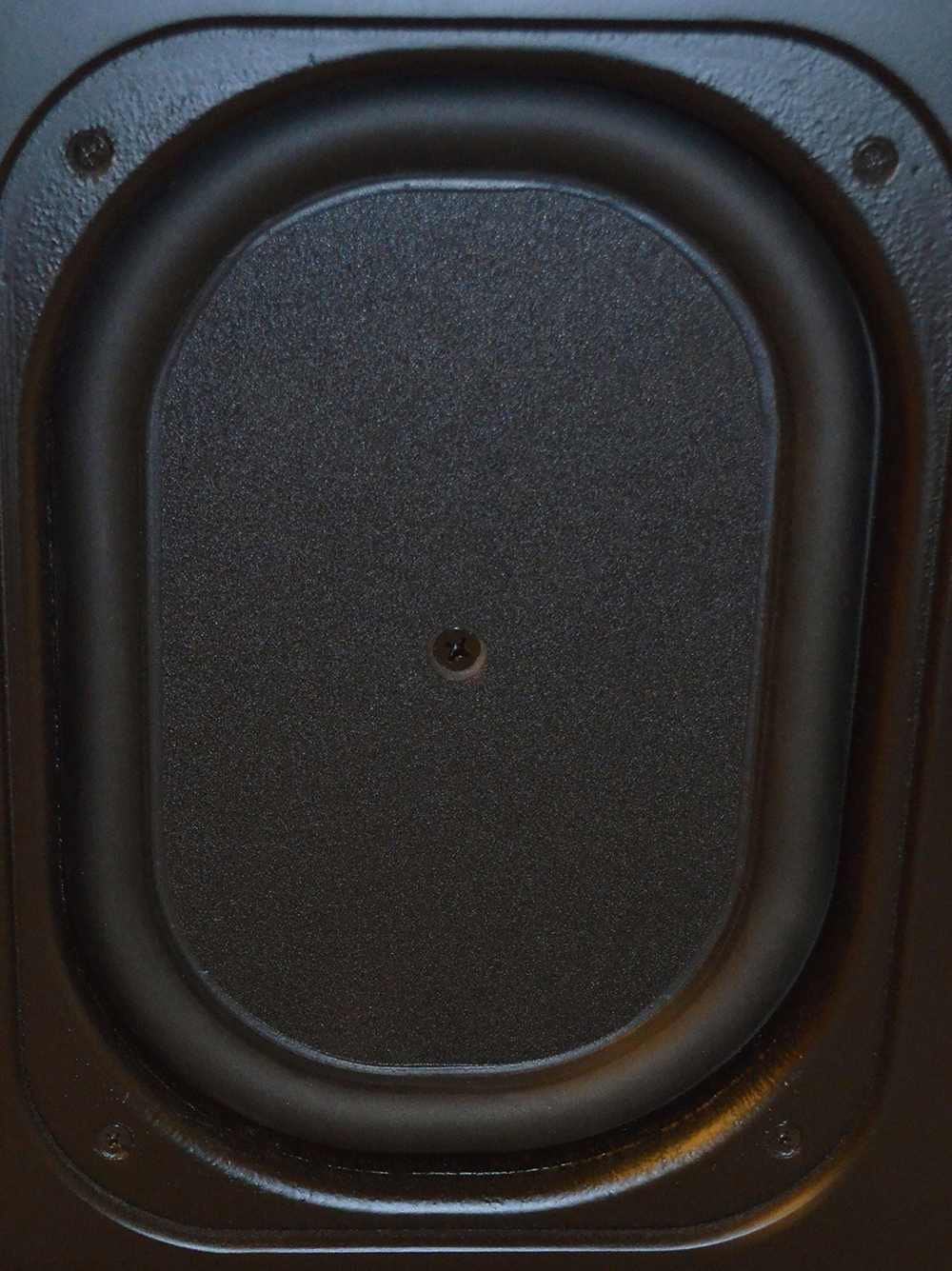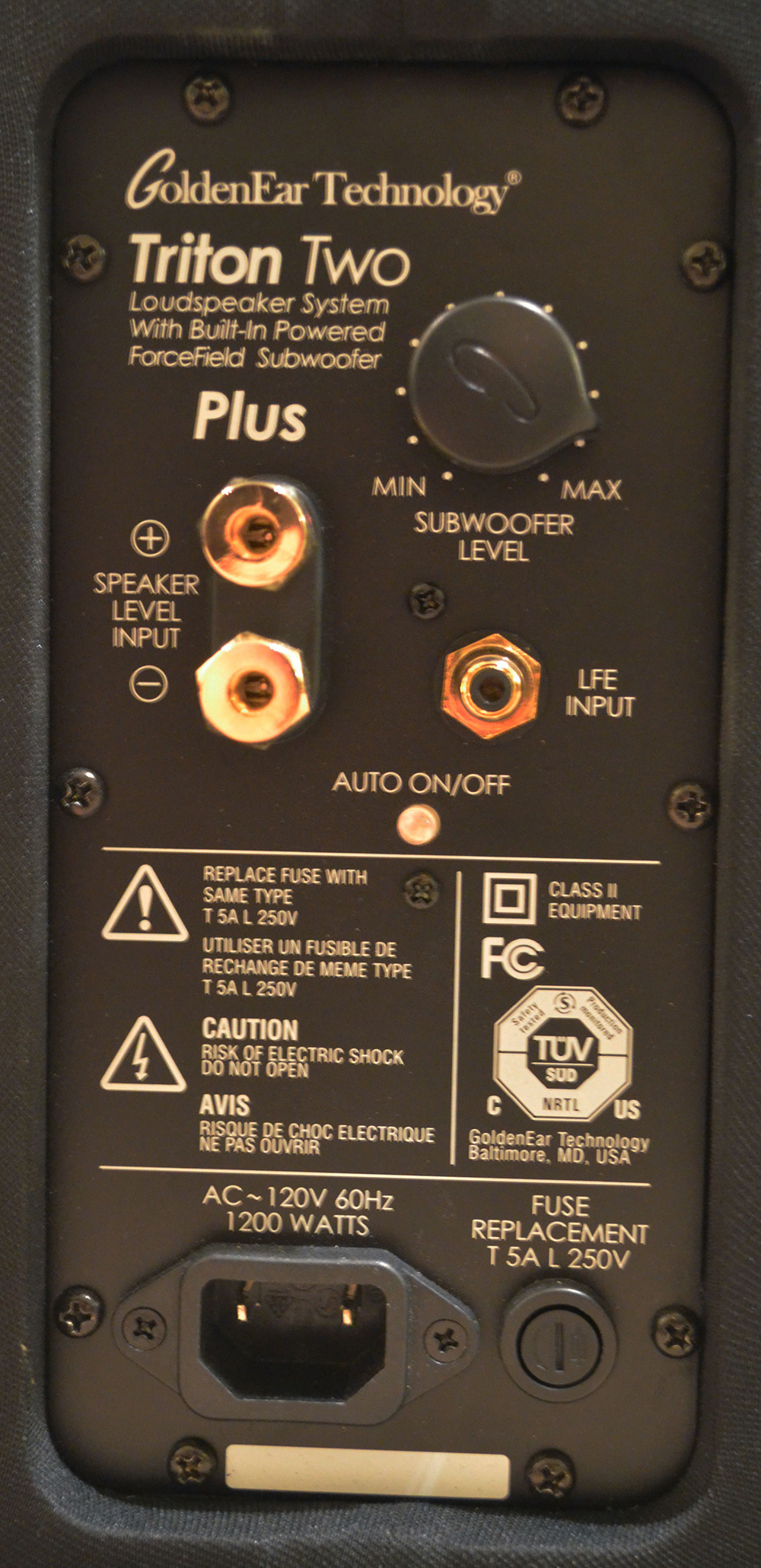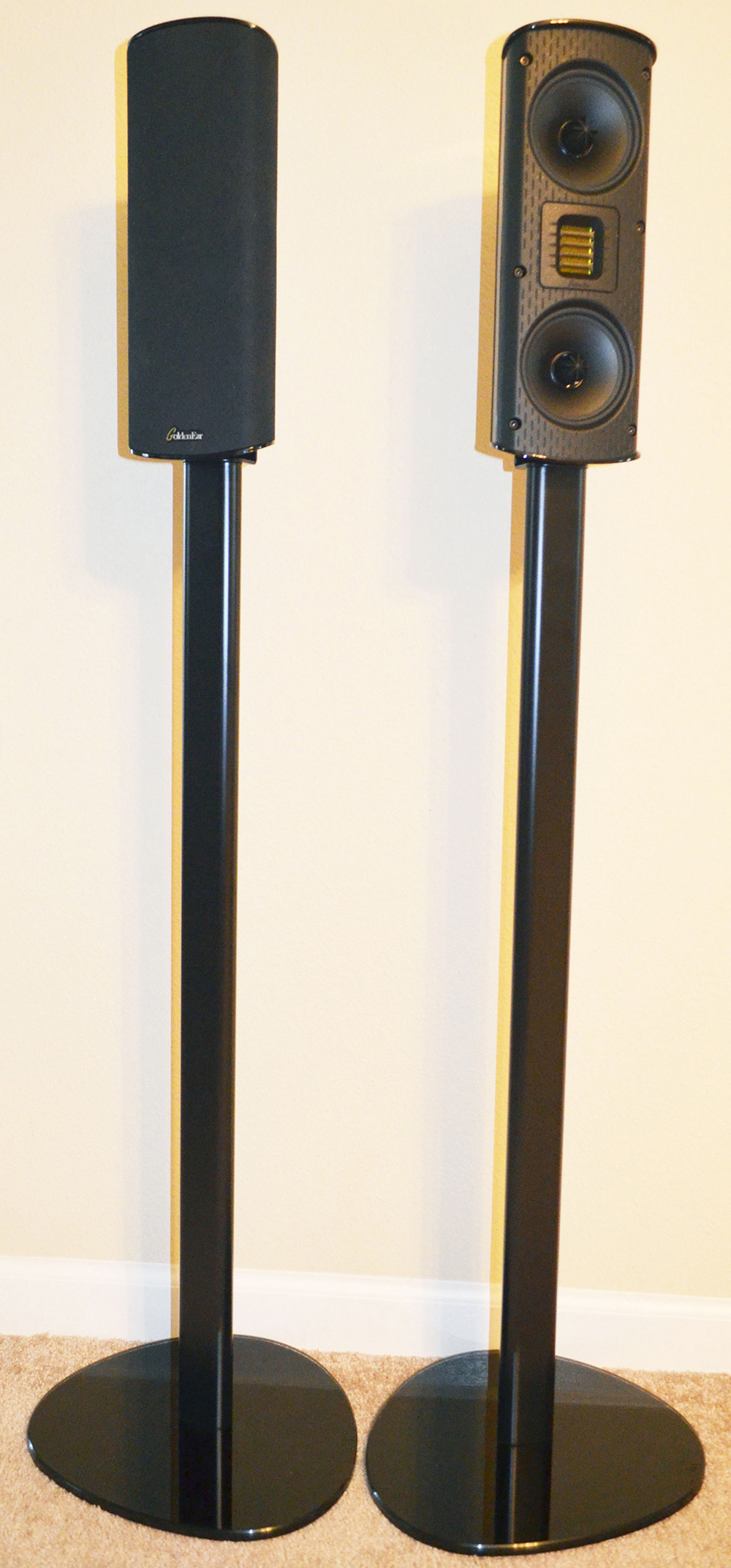While the average slim-tower speakers usually do not have the frequency-response extension to the lowest audible octave, the Triton Two+ is a proud flag-bearer of the very meaning of a full-range speaker, having a specified frequency response of 16 Hz to 35 kHz. This is possible because each speaker houses a mighty 1200 W digital amplifier to power its subwoofer section.
The Triton Two+ speakers are designed to be adept not only for stereo music listening, but also for home-theater surround application. As GoldenEar also included the SuperCenter XXL and a pair of SuperSat 3 for this review, the home theatrical performance of this five-speaker TritonCinema system will also be highlighted.

GoldenEar Triton Two+ with TritonCinema Speakers System
- Built-in powered subwoofer in the Triton Two+ tower with 1200 Watt digital amplification.
- Line-level subwoofer input for more flexible Low Frequency Effect (LFE) adjustment.
- High-quality components all around in the solidly built enclosures.
- Excellent performer in stereo and multi-channel.
The GoldenEar Triton Two+ speaker with a built-in powered subwoofer is an impressive full-range tower speaker capable of producing dynamic sounds that are rich in detail and vivid in imaging. These speakers can portray a wide and deep soundstage with ease, hence musically pleasing. Accompanied by the SuperCenter XXL and SuperSat 3, this TritonCinema system can deliver an impactful and yet refined home theater performance.
GoldenEar Technology, which is founded in 2010, is a relatively young audio company. However, the company is not young in experience though, as it is founded by Sandy Gross and Don Givogue, who are well-known veterans in the audio industry. Sandy, for example, had co-founded two successful speaker brands prior to founding GoldenEar Technology. Therefore, it is of little surprise that GoldenEar speakers, in a relatively short time, have garnered accolades and awards from various media outlets and shows, and become one of the successful brands in the audio industry.
Triton Two+ towers
Dimensions:
5-1/4"W (front) x 7-1/2"W (rear) x 15"D x 48"H
5-1/4"W (front) x 7-1/2"W (rear) x 15"D x 48"H:
Base: 11-1/2"W x 18"D
Frequency response:
16 Hz – 35 kHz
Efficiency:
91 dB
Nominal impedance:
8 ohm
Drivers:
One High-Velocity Folded Ribbon (HVFR)TM tweeter
Two 4-1/2" High-Definition Cast-Basket MVPPTM upper-bass/mid drivers
Two 5" x 9" long-throw quadratic subwoofer bass drivers
Two 7" x 10" quadratic planar infrasonic radiators
Recommended amplification:
20 – 500 watt/channel
Built-in subwoofer amplification:
1200 watt ForceField digital amplifier
Weight:
60 lbs each
MSRP:
$1750 each
SuperCenter XXL
Dimensions:
29"W x 5-3/4"H x 11"D
Frequency response:
36 Hz – 35 kHz
Efficiency:
91 dB
Nominal impedance:
8 ohm
Drivers:
One High-Velocity Folded Ribbon (HVFR)TM tweeter
Two 5-1/4" Cast-Basket mid/bass drivers
Two 6-3/4" x 8" quadratic planar low-frequency radiators
One 7" x 10" quadratic planar low-frequency radiator
Recommended amplification:
20 – 250 watt/channel
Weight:
21 lbs each
MSRP:
$1250 each
SuperSat 3 satellite speakers
Dimensions:
12"H x 4-3/4"W x 2-1/2"D
Frequency response:
60 Hz – 35 kHz
Efficiency:
92 dB
Nominal impedance:
8 ohm
Drivers:
One High-Velocity Folded Ribbon (HVFR)TM tweeter
Two 4-1/2" High-Definition Cast-Basket MVPPTM mid/bass drivers
Recommended amplification:
20 – 200 watt/channel
Weight:
7 lbs each
MSRP:
$250 each
SuperStand 3
Black metal column:
With tempered-glass base stand for SuperSat speakers
Height:
33.5"
MSRP:
$150/pair
Company:
SECRETS Tags:
GoldenEar, Triton Two+, TritonCinema, Speakers System, Speakers, Speaker Reviews 2016
Where to Buy:
Although I have known about GoldenEar speakers and their reputation since their early days, I have not had a chance to get acquaintance with their products until this review. Hence, to say I was excited in getting the opportunity to review a set of GoldenEar speakers is an understatement. But with excitement comes expectation. Although as a reviewer, I try to suppress my anticipation of a product and always start at a neutral gear, I will not hide the fact that in this case I did have a positive optimism on these GoldenEar speakers even before the start of the review. Hey after all, I am only human full of anticipation. After everything that I read and heard about GoldenEar speakers, would they live up to the hype? This system had a “large shoe to fill” indeed!
Secrets Sponsor
The GoldenEar speaker system reviewed here consists of a pair of Triton Two+ tower speakers, SuperCenter XXL, and a pair of SuperSat 3 satellite speakers with their matching SuperStand 3. Upon their arrival, I was immediately impressed by the care the GoldenEar put into their shipped speakers. The Triton Two+ and SuperCenter XXL are by no means large in themselves, but in their shipping boxes you might think they are gigantic speakers. My old-fashioned nature appreciates the extra mile the company takes in the careful shipping of its products. The main speaker in this review system, the Triton Two+, is the improved version of the previous Triton Two. In this update, some new technologies and refinements used in the Triton One, the company’s highly-regarded flagship, are incorporated. The cost of these five speakers together is $5250, which is not terribly expensive, but not cheap either. But when you consider that you do not have to spend extra on powered subwoofers, as they are built-in within Triton Two+ towers, then this system price can be considered quite competitive.
First of all, the quality of construction of these speakers is solid. Based on the speakers’ appearances, especially the Triton Two+ and the SuperCenter XXL, I would guess that the design emphasizes function over form, although I can say that the latter is not completely left out either. This is obvious from the addition of glossy-black panels that compliment the black “socks” that cover most of the speaker’s body and the use of round metal grills on the Triton Two+ to reduce the plainness of the sock. The form of the speakers may not be sculpture-like; they however do sport handsome looks that are quite easy on the eyes.
Secrets Sponsor
The geometry of the GoldenEar Triton Two+ speakers departs from the usual rectangular-boxy fashion. The Triton Two+’s have a curved rear baffle that tapers to rounded narrow front baffles. Its front, sides, and rear surfaces are mostly wrapped in the black fabric sock. Glossy black panels are used as the top cover and the stabilizing base of the speaker. The top panel material is plastic (ABS) while the speaker’s base is made from medite (MDF). This base, which is attached to the speaker using four screws, provides a stable foundation for the speaker. GoldenEar provides spikes or rubber feet for more stability. The familiar sock hides the speaker’s drivers as well as the rounded front metal grill. Generally, I am not a big fan of the look of sock-covered speakers such as these, but the combination of the glossy-black top and bottom panels along with the rounded geometry of the enclosure does work in generating a handsome look in this case.
The Triton Two+ uses an impressive array of high-quality drivers. Its 4-1/2" midrange and folded-ribbon tweeter drivers are arranged in a D’Appolito configuration, where midrange drivers flank the tweeter vertically. The tweeter is placed on the chassis at about an average sitting-down listener’s ear height. Below the lower midrange driver is the Triton Two+’s subwoofer section, which has two 5" x 9" quadratic bass drivers on the front baffle and two 7" x 10" planar radiators. These bass drivers are powered by a whopping 1200 Watt digital amplifier. So even though the bass drivers are relatively small, the powerful amplifier with the help of the radiators is able to push the drivers to move enough air to produce sub 20-Hz bass.
GoldenEar also makes use of high-quality crossovers that significantly affect the sound quality. The speaker connectors, subwoofer volume control, as well as the power cord receptacle of the Triton Two+ are located on the lower rear-panel of the speaker. There is also a single-ended Low Frequency Effect (LFE) input for connecting line-level subwoofer output of the surround processor directly to the speaker, bypassing the low-frequency crossover within the Triton Two+. Using this option is like having two separate subwoofers handling the LFE signals, hence the level for the LFE channel can be adjusted through the surround processor independently from the front speakers. Moreover, Sandy informed me that most surround processors attenuate and roll-off the redirected LFE signals, and thus connecting the subwoofer output from the processor directly to the Triton Two+’s LFE inputs would improve the bass response.
As the name implies, the SuperCenter XXL is a rather large center channel. It is relatively wide and deep, but it has a low height profile. It has similar look to the Triton Two+ towers as most of the speaker body is covered by the black fabric sock. Glossy-black left and right panels give a design accent to an otherwise plain-looking speaker appearance. The SuperCenter XXL has the same tweeter as the TritonTwo+. The midrange and bass are handled by two 5-1/4" cast-basket drivers augmented by two 6-3/4" x 8" and one 7" x 10" planar low-frequency radiators, which occupy the top baffle of the speaker. Therefore, a minimum of 2" clearance from the top baffle of the speaker is suggested to get an optimal performance. Threaded brass inserts and adjustable rubber feet are included to adjust the angle of the speaker.

Compared to the other speakers in the set, the SuperSat 3 looks petite. This compact satellite speaker features the same type of tweeter as the other speakers in the Triton families. The tweeter is flanked by two 4-1/2 cast-basket mid/upper bass drivers. On the back of the SuperSat 3, there is a keyhole for wall mounting. The matching stands for shelf or table-top mount are also included. The SuperSat 3 is capable of anchoring the front channels in a small home-theater setup, however for this review they are used solely as surround-channel speakers mounted on the SuperStand 3, which needs to be assembled before use. Except for one screw that seemed to have an imperfect thread and could only be tightened half way, I did not experience any difficulty in assembling the stands. Overall the stands provide a solid support and put the SuperSat 3 in the right height for optimal sound performance. The combination of the black metal pole and glass base elegantly matches well with the appearance of the SuperSat 3.
For the review, the speakers were placed in their respective locations in my reference setup. I paid special attention to the placement and toe-in of the Triton Two+ speakers, as they might affect significantly the stereo performance of the speakers. Following the placement suggestion given in the manual, the two speakers and my listening position formed an equilateral triangle with about 9-ft sides. The speakers were toed-in such that the front baffle of each speaker was directed toward the respective ear of the listener in the main listening position. The back of the Triton Two+ speakers were about a foot and a half away from the wall. The SuperCenter XXL was placed horizontally on the table stand below my 65" Sony TV. It was about a foot below listeners’ ear level in seated position, but this did not seem to have an adverse effect to the speaker’s performance. The SuperSat 3 were placed to the sides of the seating area, at about 9 ft from the center seating position. Their front baffles were aimed directly at the seating area.
The Triton Two+ speakers were plugged in to different electrical sockets located on the wall just behind them. The built-in amplifiers of the powered subwoofers are equipped with an auto on/off feature. There is also a small blue LED indicator on the back of the speaker near the subwoofer level control that is light up when the speaker is actively receiving an audio signal. Following the suggestion in the manual, initially I set the subwoofer level control at 12 o’clock position on both speakers. In my listening room however, which is relatively large and open, this setting did not produce sufficient bass. A few adjustments on the position of the speakers, their separation distance, toe-in angle, and volume level were made before I felt satisfied with the amount and quality of bass produced. I ended up with the subwoofer level control at about the 2 o’clock position on both speakers.
As the correct subwoofer setting is crucial for getting the optimum bass performance from the Triton Two+ speakers, I was thinking if there were some other controls besides just the volume level to assist in getting the proper subwoofer level without having to rely on re-adjusting the position and orientation of the speakers, for example phase control. However, Sandy explained to me that phase control could do more harm than good in this case, especially because GoldenEar has spent a considerable effort in getting the crossover frequency and phase adjustment just right especially between the upper and lower frequency ranges. Allowing the user to set the wrong adjustments can easily destroy the smooth transitions between the midrange and bass drivers in the frequency response.
During both stereo and surround evaluations, no additional subwoofer was used. The Triton Two+ were run full range in both setups. For the stereo-music evaluation, the front-end components I paired the Bel Canto CD3t CD transport and DAC2.5, channeled through a Krell KAV-250p preamplifier, which also provides a unity-gain pass-through for easy home-theater integration. The stereo amplifiers from Bel Canto (EVO200.2 and S300) as well as the Krell KAV-300iL integrated amplifier were used to drive the Triton Two+ speakers. For the home-theater evaluation, my Classe SSP-300 served as the surround processor with the Krell Showcase five-channel amplifier powering the SuperCenter XXL and the SuperSat 3 speakers.
The center channel and surround speakers were crossed over at 80 Hz during the evaluation. Two different bass-management settings on the surround processor for multi-channel playback were tried on during the review. In the first setting the subwoofer was set to “no”, hence the LFE signals were redirected to the front full-range speakers. In this case, only a speaker-level connection from the amplifier to the Triton Two+ was used. In the second setting, the subwoofer was set to “yes”, while the front speakers were still run in full range. With this setting, both speaker-level from the amplifier and line-level subwoofer-out from the surround processor were connected to the Triton Two+.
I began evaluating the stereo performance of the GoldenEar Triton Two+ speakers after I considered the speakers had been fully broken-in. I was immediately impressed by the all-around performance of these speakers. The Triton Two+ speakers produce well-balanced sound across the audible frequency spectrum: awesome rich-in-detail highs and full articulate bass. In the bass department, these speakers might seem to go against the law of physics, which usually requires the use of big drivers to move a large volume of air to produce the bass to the lowest octave. My NHT Evolution T6 speakers, for example, use four 12" bass drivers to reach the full-range status. By comparison, the bass drivers in the Triton Two+ are relatively small, but they can move the necessary volume of air for the full-range bass with a clever design utilizing the powerful built-in 1200 W digital amplifier and the passive radiators. Additionally, the smaller bass drivers have the advantage in speed, which may be the reason why the Triton Two+ bass never sounds sluggish. I find the bass of the Triton Two+ overall tuneful and yet powerful. Never once did I feel the urge for additional bass from my subwoofer.

Good-recordings sound very clear and transparent through the Triton Two+, just like having a live musical performance playing in front of me. Moreover, the speakers’ ability to convey details in the recording is nothing short of amazing.
On the beginning of the track “Little Girl Blue” from The Very Best of Diana Krall album (2007), the friction sound of the bow rubbing the cello string was portrayed clearly by the Triton Two+, rendering a sense of realism. Similarly, the sound of the wire brush hitting the drum on the track “Fly Me to the Moon” from the same album was portrayed to the level of detail that almost made me swear that I heard the sound of individual brush wires striking the surface of the drum one by one.

Vocals sounded natural and full-bodied through the Triton Two+. In listening to Diana Krall’s Wallflower album (2014), these speakers had no problem in convincing me that I was listening to the singer up close in front of me. Her breathing and sibilance are conveyed realistically by the speakers.
I should point out that the Triton Two+ speakers are very neutral, and as such they will not make the vocal any more lush than what is actually conveyed by the recording and the front-end components. Depending on your taste, this may or may not be desirable. As for me, I like speakers that somehow convey the sense of rawness in the music they play like the Triton Two+ as they instill a high-degree of sonic realism.
The drums sounded nicely placed in the back of the stage while the singer’s voice was intimately close and up front while the other instruments were very stable on the stage with clear separation among them. These speakers have no problem creating sonic images beyond the speakers’ borders.

The capability of the Triton Two+ speakers to just disappear sonically and leave the listener with vivid imaging in a realistic three-dimensional soundstage is outstanding. GoldenEar considers the imaging capability of their speakers as one of the key design points, and the Triton Two+ exemplifies the achievement of this very design objective. As I listened to the track “I’m So Lonesome I Could Cry” from Cassandra Wilson’s New Moon Daughter album (1995), I could not resist admiring the deep and wide sonic image the speakers rendered.
The Triton Two+ speakers are also superb in rendering dynamics in the program materials. Music played through them always sounds full of sonic textures and never dull-sounding. These speakers convey the energy in the music very well, creating a believable listening atmosphere. As a revealing speaker, the performance of the Triton Two+ speakers is very much affected by the upstream components used. From the three amplifiers that I tried on the speakers, I got the best result when driving them with the Bel Canto S300 amplifier. In my opinion this combination gave me the fullest mid-range with just the right amount of upper-end extension. I found that driving the Triton Two+ with the Krell KAV-300iL resulted in sonic characteristics that were just a tad too bright for my taste.
I think you can tell by now that I am deeply impressed with the Triton Two+. Their solid sonic performance makes it hard not to like them. But nothing is universal, especially on something that involves a subjective opinion on the sonic preference. The Triton Two+’s for example are very revealing and thus may give an impression of a slight lack of high-frequency smoothness in their presentation. This may not be bad as it renders more textures in the music. Also the musical presentation of the Triton Two+ speakers is slightly forward and thus, creating an intimate listening stage. People, who gravitate towards a laid-back British made speaker type of sound, may find the Triton Two+ presentation too forward for their taste. But regardless of your sonic preference, for the price there is no denying that at $3500 per pair, the Triton Two+ speakers offer a high level of performance.
As for home-theater/surround applications, there is no question that the Triton Two+ speakers are solid front-channel anchors. In the review system, the Triton Two+ is complemented by the SuperCenter XXL and SuperSat 3 in a five-speaker TritonCinema surround setup. Stating this surround system rocks is an understatement. Having experienced many surround speaker systems, I can comfortably say that the performance of the TritonCinema setup can easily rival and surpass more expensive systems out there.
First of all, since all the speakers in the system use the same type of tweeter and mid-bass drivers, the timbre match of the system is excellent. There is no noticeable change in sonic characteristics as the sound pans across the speakers. I always believe that the center channel speaker is crucial to the performance of the surround speaker system. And let me tell you that the SuperCenter XXL is an awesome center channel. At $1250, it is one of the most expensive center channel speaker that has ever visited my system, but it is also one of the best that I have ever tried. Its performance really justifies its price.
Physically, the SuperCenter XXL’s low height can be deceiving, but its dynamic range can challenge some of the bigger speakers out there. The passive radiators on the top baffle of the SuperCenter XXL help in aiding the lower frequency range of the speaker. This speaker is capable of playing loud without any hint of congestion even in the most demanding soundtracks. Most importantly in a center channel, dialogues sound clear and crisp through the SuperCenter XXL. Also the horizontal and vertical sonic-dispersion characteristics of the speaker are excellent. I did not notice any discernible degradation in clarity or sound quality from this center channel as I shifted to the left or right by three or four-feet away from the center seating position. Similarly, even though my ear level was about a foot higher than the center channel, which was put horizontally, I felt that I still got the optimal sound from it and did not feel the need to add any inclination to the speaker.

The surround speakers, the SuperSat 3, look slim and small, but they are more than capable of complementing the big boys in the group. They do not sound small at all and can handle significant power without sounding edgy or congested. The battle scenes in the movie “The Water Diviner” (2014) contain significant amount of sonic energy coming from all directions, including from the direction of the surround speakers. The SuperSat 3 had no problem in delivering this sonic message with aplomb, giving me the feel as if I was in the middle of the actions.
The scenes also highlight the capability of this GoldenEar surround speaker system to deliver full-of-energy dynamic home-theater sound without flinching. The built-in powered subwoofers in the Trition Two+ towers also have no problem in delivering the prodigious bass energy in the soundtrack. Is there a difference in the bass response between the two bass-management settings tried (mentioned in the previous section)? The short answer is yes, but the difference is subtle and only noticeable on program materials with a lot of LFE content. I would be happy with either setting; however I did hear slightly enhanced bass response when the direct line-level LFE connection was used. Moreover, I could increase the subwoofer level setting through the surround processor to obtain more LFE enhancement for a more impactful movie experience.

This surround speaker system further amazes me with its ability to deliver delicate program materials requiring finesse. Ambience or background music sounds nice and smooth through the TritonCinema system. One of my recent favorite television shows, the Blacklist, which is delivered in high-definition with 5.1 Dolby Digital surround, has lively action-filled tracks intertwined with wonderful musical tracks.
Gordon Lightfoot’s song “If You Could Read My Mind”, which appeared toward the end of the show’s season 4, episode 2, sounded so sweet through the TritonCinema surround system. It was an old song that I have known for a long time but almost forgotten, and surely I have not remembered hearing it at the level of sweetness that the GoldenEar system delivered. Perhaps I should credit this GoldenEar system for rejuvenating my fondness for the song. Surely this is a testament of how good this GoldenEar system is.
Anchored by the Wonderful TRITON TWO+ TOWERS, The Tritoncinema Five-speaker System Delivers Stereo and Home-theater Performances That Excel in all Critical Aspects of the Sound, Setting a High Standard in Performance-to-cost Ratio That is Hard yo Beat in its Price Class.
- Wonderful sounding Triton Two+ speakers
- Excellent center channel in the SuperCenter XXL
- Overall smooth and impactful surround performance from the TritonCinema system
- Built-in powered subwoofers in the Triton Two+ with the provision for line-level LFE inputs
- Handsome appearance and solid built quality
- Nada, can’t think of a thing
I am happy to report that the GoldenEar TritonCinema system had no problems easily filling the proverbial shoes. The experience of the people behind GoldenEar products does show through in the TritonCinema speaker system reviewed here, which easily met my expectation and then some. A lot of things to like about this speaker system, starting from the use of the high-quality components in the solidly built and good-looking enclosures to its strong all-around performance that did not seem lacking in all aspects of the sound. In stereo music applications, the Triton Two+ pair exhibit outstanding sonic attributes, such as a high degree of transparency, detail-rich dynamics, and vivid imaging, which can easily rival speakers above this price range. While no product is perfect and their sonic characteristics may not satisfy everyone’s taste, there is no question that these speakers set the performance bar very high by any standard, so high that it is almost untouchable in their price class. Moreover, credit goes to the versatile Triton Two+ with their highly dynamic sound, capable of producing full-range bass in the TritonCinema five-speaker system for an impactful yet refined home-theater surround performance. Highly recommended!


